24 Hours Hotline: +86 137-3541-1378
Email:beijing@tripstoshanghai.com
24 Hours Hotline: +86 137-3541-1378
Email:beijing@tripstoshanghai.com
Introduction
The Confucius Temple in Beijing stands as one of the city’s most revered cultural and historical landmarks, second only to the grand temple in Confucius’s hometown of Qufu. Built in 1302 during the Yuan Dynasty, it covers an impressive 22,000 square meters and provides a serene escape from the bustling capital. Dedicated to honoring the great philosopher Confucius, the temple served as a site for imperial scholars to pay tribute and hold ceremonies for centuries. Within its tranquil courtyards, visitors will find ancient steles engraved with the names of successful imperial examination candidates, beautifully carved stone tablets, and ornate memorial halls that reflect deep respect for learning and virtue. The architecture, with its traditional red walls, yellow glazed tiles, and intricate wooden carvings, embodies the harmony and balance central to Confucian ideals. For travelers eager to explore Chinese philosophy, education, and artistry, the Confucius Temple offers a profound glimpse into the intellectual soul of ancient China and the lasting influence of Confucian thought.
.jpg)
.jpg)
Historical Background of the Confucius Temple in Beijing
The Confucius Temple in Beijing was first constructed in 1302 during the Yuan Dynasty and later expanded through the Ming and Qing dynasties, reflecting centuries of imperial reverence for Confucian values. Emperors once visited this sacred site to offer sacrifices to Confucius, honored as the “Great Sage and Teacher,” as a way of promoting moral governance and respect for education. Located beside the Imperial Academy (Guozijian), the temple formed a vital part of China’s ancient education system. Scholars who passed the rigorous civil service examinations would come here to pay homage to Confucius before beginning their official careers. Over time, the temple became not only a place of worship but also a symbol of intellectual pursuit and virtue, preserving a rich legacy of Confucian ceremonies and scholarly traditions that shaped Chinese society for over seven hundred years.
.jpg)
.jpg)
Architectural Highlights of the Confucius Temple in Beijing
The Confucius Temple in Beijing stands as an exquisite example of traditional Chinese architecture that blends beauty, symbolism, and spiritual meaning. Every element of its design reflects the Confucian pursuit of harmony, respect, and moral order. The temple complex is arranged along a symmetrical north–south axis, a layout common in imperial architecture that emphasizes balance and dignity. From the moment visitors step through the grand entrance, they are guided through a sequence of courtyards and ceremonial halls, each representing a higher level of reverence. The setting feels peaceful yet majestic, filled with ancient cypress trees, carved stone steles, and the faint echoes of scholars who once gathered here. The temple’s architecture does more than impress the eye—it tells the story of China’s intellectual heritage, celebrating the timeless influence of Confucianism on Chinese art, education, and moral philosophy.
1. Main Layout – Harmony and Order
The architectural layout of the Confucius Temple follows a traditional symmetrical design centered on a main axis that extends from the Lingxing Gate to the Dacheng Hall. This structure symbolizes the Confucian ideals of order, discipline, and harmony between heaven, earth, and humanity. Visitors move through a series of courtyards—each one more solemn than the last—mirroring the process of advancing toward enlightenment and wisdom. The outer courtyards serve as gathering spaces, while the inner areas are reserved for ceremonies and offerings to Confucius. The alignment of buildings, gates, and trees creates a sense of rhythm and calm, guiding guests naturally through the temple’s sacred atmosphere. This carefully planned design not only reflects ancient Chinese architectural mastery but also acts as a physical expression of Confucian philosophy, where every step represents respect, learning, and the pursuit of moral perfection.
.jpg)
.jpg)
2. Famous Structures – Halls of Reverence
Among the temple’s many magnificent structures, several stand out for their grandeur and symbolic importance. The most prominent is Dacheng Hall, or the Hall of Great Accomplishment, which serves as the spiritual center of the complex. With its towering wooden pillars, golden roof tiles, and intricate carvings of dragons and phoenixes, the hall was where emperors once offered grand sacrifices to Confucius. In front of it stands the Dacheng Gate, marking the transition from the outer to the inner sanctum, signifying reverence and purity before entering the sacred area. The Lingxing Gate, located at the entrance, represents the gateway to knowledge and virtue. Each structure within the complex is built using traditional materials—wood, stone, and glazed tiles—showcasing the refined craftsmanship of the Ming and Qing dynasties. Together, these architectural masterpieces form a harmonious ensemble that embodies the respect and admiration the Chinese people have long held for their “Great Sage and Teacher.”
.jpg)
.jpg)
3. Stone Steles and Ancient Cypresses – Living History
The Confucius Temple is also famous for its collection of over 190 stone steles, many engraved with the names of scholars who passed the imperial examinations during the Yuan, Ming, and Qing dynasties. These inscriptions immortalize generations of talented individuals who dedicated their lives to Confucian learning. Some steles record imperial edicts honoring Confucius, while others celebrate scholarly achievements, turning the temple grounds into an open-air museum of China’s educational history. Surrounding the steles are ancient cypress trees, some more than 700 years old, whose twisting trunks and dense foliage add an air of wisdom and endurance. One particularly renowned tree, known as the “Touch Evil Cypress,” is said to have punished corrupt officials who brushed against it. These living relics connect visitors to centuries of devotion, scholarship, and moral reflection, making the temple a rare place where nature, history, and culture intertwine harmoniously.
.jpg)
.jpg)
4. Symbolic Design – A Reflection of Confucian Ideals
Beyond its impressive structures and historical artifacts, the temple’s architectural symbolism reveals the essence of Confucian philosophy. The red walls and yellow glazed tiles signify loyalty, dignity, and imperial respect, while dragon and phoenix motifs carved into beams and doors symbolize balance between heaven and earth. The placement of halls and gates follows feng shui principles, designed to maintain harmony and ensure that energy flows smoothly through the complex. Every detail—from the shape of the roofs to the patterns on stone pathways—reflects the Confucian belief in order, moderation, and moral beauty. The temple’s quiet courtyards and balanced design evoke a sense of peace and introspection, inviting visitors to contemplate not only the wisdom of Confucius but also the timeless values of virtue, respect, and self-cultivation. It stands as a living embodiment of Confucian ideals expressed through architecture—graceful, dignified, and deeply meaningful.
.jpg)
.jpg)
Top Things to See and Do at the Confucius Temple in Beijing
The Confucius Temple in Beijing offers visitors a rich blend of history, culture, and architectural beauty, making it an unmissable destination for anyone interested in Chinese philosophy and heritage. The temple is more than a static historical site—it is an immersive experience where guests can stroll through serene courtyards, admire ancient craftsmanship, and reflect on centuries of scholarly tradition. Each section of the temple tells a story, from the sacred halls where emperors once paid homage to Confucius to the stele collections that record the achievements of countless scholars. Whether visiting alone or combining the trip with the nearby Imperial Academy (Guozijian), travelers will find an engaging journey into China’s intellectual and cultural past. The temple’s calm atmosphere, historical significance, and stunning architecture create a space that invites both exploration and contemplation, making it a perfect destination for history buffs, culture enthusiasts, and those simply seeking a moment of tranquility in the heart of Beijing.
1. Walk Through the Peaceful Courtyards
One of the most memorable experiences at the Confucius Temple is walking through its quiet, expansive courtyards. Lined with ancient cypress trees, some over 700 years old, these courtyards create a serene and contemplative environment. The trees, with their gnarled trunks and lush green canopies, provide both shade and a sense of timelessness, connecting visitors with the generations of scholars who once walked the same paths. The courtyards are carefully designed to maintain harmony and balance, allowing guests to experience the temple’s layout in a natural, flowing progression. Strolling through these spaces, visitors can pause to admire the subtle details of traditional architecture, from the carved wooden doors to the decorative roof tiles, making it an ideal place for photography, quiet reflection, and appreciation of historical design.
.jpg)
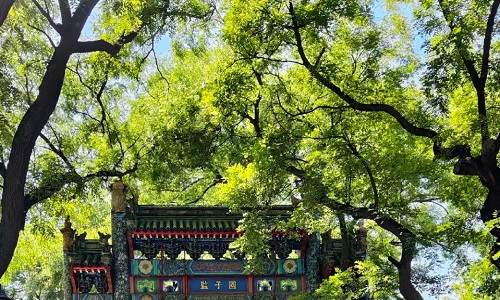
2. Visit the Dacheng Hall
At the heart of the Confucius Temple lies Dacheng Hall, or the Hall of Great Accomplishment, the largest and most important building in the complex. This grand hall houses statues of Confucius and his notable disciples, as well as ancient ritual instruments used during ceremonial offerings. The hall’s impressive wooden beams, gilded roof tiles, and intricate carvings reflect the highest level of Ming and Qing craftsmanship. Visitors can admire the solemnity of the space, where emperors and scholars once gathered to honor Confucius’s teachings. The hall not only serves as the spiritual center of the temple but also offers insight into traditional ceremonial practices, highlighting the connection between Confucian philosophy, education, and moral governance in China’s history.
.jpg)
.jpg)
3. Explore the Stele Pavilion
The Stele Pavilion is another must-see feature within the temple grounds, home to more than 190 stone steles engraved with the names of scholars who passed the imperial examinations. These inscriptions span several dynasties and serve as a tangible record of China’s scholarly achievements and reverence for learning. Some steles also feature imperial edicts praising Confucian virtues or commemorating important ceremonies held at the temple. The pavilion is both an architectural and cultural highlight, allowing visitors to immerse themselves in the intellectual history of China. As guests walk among the steles, they gain a sense of the immense value placed on scholarship, morality, and dedication to education, which remain core principles of Confucian thought.
.jpg)
.jpg)
4. Combine Your Visit with the Imperial Academy (Guozijian)
For a fuller experience, visitors can also explore the Imperial Academy (Guozijian) next door, historically the highest institution of learning in imperial China. Together, the temple and the academy provide a comprehensive look at the educational and ceremonial systems rooted in Confucian ideology. The Guozijian features lecture halls, study rooms, and examination spaces where scholars were trained and tested for civil service positions. Combining the two sites allows travelers to see how Confucian teachings were applied in practice, from philosophical study to the administration of government. This combined visit not only enriches understanding of China’s intellectual history but also deepens appreciation for the seamless integration of culture, education, and ritual in traditional Chinese society.
.jpg)
.jpg)
Cultural Significance and Traditions of the Confucius Temple in Beijing
The Confucius Temple in Beijing is much more than an architectural landmark—it is a living symbol of China’s enduring intellectual and moral traditions. Serving as a center of Confucian worship and education for centuries, the temple played a vital role in promoting values such as respect, wisdom, benevolence, and harmony. Each year, on Confucius’ birthday (September 28), the temple hosts elaborate ceremonies that recreate ancient rituals, complete with traditional music, offerings, and formal bows to honor the “Great Sage and Teacher.” These ceremonies allow visitors to witness the continuity of Confucian customs and understand how deeply they shaped Chinese society. Stories associated with the temple—ranging from imperial tributes to the achievements of civil service scholars—connect modern guests with a scholarly past that prized learning, moral cultivation, and social responsibility. Through its festivals, rituals, and educational legacy, the Confucius Temple remains a vibrant bridge between ancient philosophy and contemporary cultural appreciation, offering a profound experience of China’s spiritual and intellectual heritage.
.jpg)
.jpg)
Seasonal Experiences at the Confucius Temple in Beijing
1. Spring – Blossoms and Gentle Strolls
Spring is a particularly charming season at the Confucius Temple, when the courtyards and pathways are dotted with colorful blossoms. The mild temperatures make it ideal for exploring the temple’s expansive grounds without the intensity of summer heat. Visitors can enjoy walking along tree-lined paths, admiring the elegant architecture framed by fresh greenery, and pausing by stone steles and memorial halls. The vibrant yet gentle spring environment enhances the sense of calm and reflection that pervades the temple, making it a perfect time for families, students, and travelers interested in both culture and nature to experience the site at its most inviting.
2. Summer – Shaded Paths and Lively Atmosphere
During summer, the Confucius Temple remains a cool retreat thanks to its ancient cypress trees providing ample shade along the courtyards and walkways. The temple sees more visitors during this season, including groups of students and tourists, creating a lively and energetic atmosphere. Despite the increased activity, the design of the temple ensures that its peaceful character is preserved, allowing guests to enjoy ceremonial halls, steles, and gardens at a comfortable pace. Summer also brings vibrant lighting and strong contrasts for photography, highlighting the intricate details of the temple’s traditional roofs, gates, and ornamental carvings against lush greenery.
3. Autumn – Golden Leaves and Festival Vibes
Autumn is widely considered the best season for visiting the Confucius Temple, as the ancient cypress trees and surrounding plants turn golden and amber, creating a stunning backdrop for photography. The cooler temperatures make walking through the courtyards a comfortable and contemplative experience. Autumn is also a time for cultural festivals, particularly ceremonies celebrating Confucius’ birthday, which may start preparations as early as September. The combination of colorful foliage, crisp air, and rich cultural activity makes autumn a favorite season for visitors who want to immerse themselves in both natural beauty and traditional Confucian practices.
4. Winter – Calm and Reflective Ambiance
Winter brings a quiet and contemplative atmosphere to the Confucius Temple, as fewer visitors explore the grounds. The bare branches of the cypress trees and the clear, crisp sky create a sense of solemnity and reflection, allowing guests to focus on the spiritual and educational aspects of the site. Snow, when it falls, adds a delicate layer to the rooftops and courtyards, enhancing the temple’s serene beauty. Winter is ideal for visitors seeking solitude, meditation, or in-depth exploration of the historical steles and ceremonial halls without the distraction of crowds, offering a uniquely peaceful experience that highlights the enduring wisdom and harmony of Confucian teachings.
Nearby Attractions and Day Tour Options Around the Confucius Temple
The Confucius Temple is ideally located in central Beijing, making it easy to combine a visit with several nearby cultural and historical attractions. Its proximity to other landmarks allows travelers to create a rich and varied day tour that blends Confucian, Buddhist, and local Beijing culture. Beyond the temple’s serene courtyards and ceremonial halls, visitors can explore other sites that complement the temple’s history, offering deeper insight into China’s intellectual, religious, and everyday life. Whether you are interested in education, spirituality, or urban exploration, these nearby attractions provide a well-rounded experience, allowing you to see different facets of Beijing within a single day.
1. Guozijian (Imperial Academy) – A Center of Ancient Learning
Located just next to the Confucius Temple, the Guozijian, or Imperial Academy, was once the highest institution of learning in imperial China. It served as the pinnacle of Confucian education, training scholars and officials who would go on to pass the rigorous civil service examinations. The complex includes lecture halls, study rooms, examination spaces, and beautiful courtyards that illustrate the traditional educational environment of ancient China. Visiting Guozijian after the Confucius Temple provides a seamless historical experience, showing how Confucian philosophy was taught and practiced. The Imperial Academy also features historical artifacts, calligraphy, and inscriptions that highlight the scholarly achievements of generations of Chinese students, making it a must-see for anyone interested in China’s intellectual heritage.
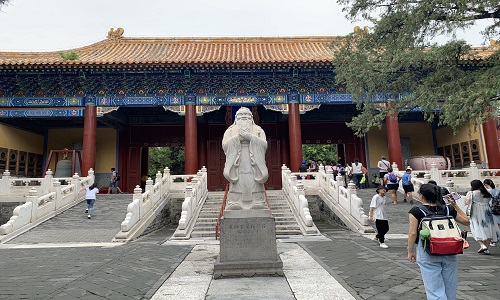
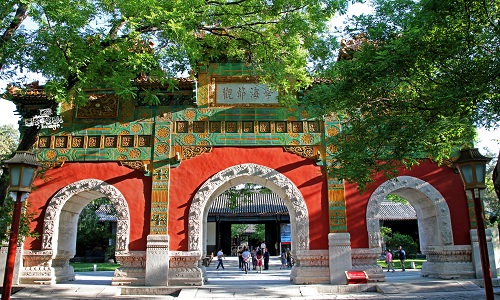
2. Lama Temple (Yonghe Temple) – Tibetan Buddhist Culture in Beijing
Just a short walk from the Confucius Temple, the Lama Temple, also known as Yonghe Temple, offers visitors a fascinating glimpse into Beijing’s Tibetan Buddhist tradition. Established in the 17th century, this monastery features grand halls, intricate carvings, and brightly colored murals, creating a striking contrast to the Confucian austerity of the nearby temple. The temple is still active, and visitors can observe monks performing rituals, listen to the chanting, or admire the massive statues of Buddhas and Bodhisattvas. Combining a visit to the Lama Temple with the Confucius Temple gives a unique opportunity to explore two major philosophical and spiritual traditions that have shaped China’s culture and history, from Confucian ethics to Tibetan Buddhist practices.
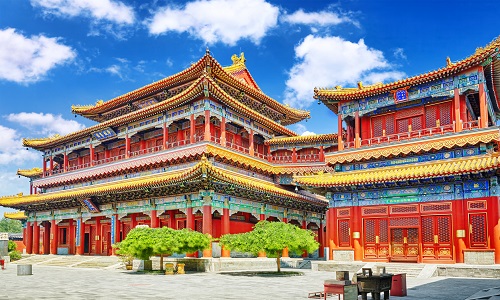
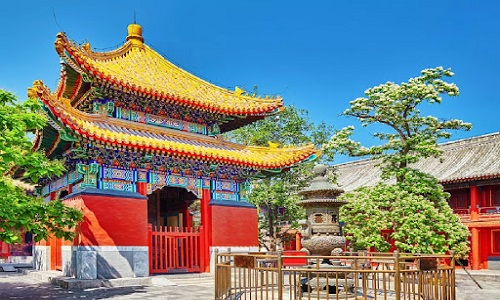
3. Nanluoguxiang Hutong – Explore Local Life and Cafés
After visiting the Confucius Temple and nearby historical sites, a stroll through Nanluoguxiang Hutong provides a refreshing contrast with a taste of modern Beijing life. This narrow alleyway is lined with traditional courtyard homes, boutique shops, and charming cafés, offering a glimpse into local culture and everyday activities. Visitors can stop for a coffee, sample local snacks, or browse unique handicrafts while enjoying the architecture of old Beijing. The hutong’s lively yet intimate atmosphere makes it a perfect ending to a day of sightseeing, allowing travelers to experience both the historical depth of Confucian and imperial landmarks and the vibrant, lived-in culture of the city’s traditional neighborhoods. Combining these attractions creates a full and memorable day tour in Beijing, blending history, spirituality, and modern urban charm seamlessly.
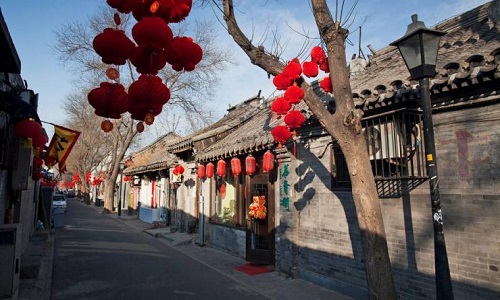
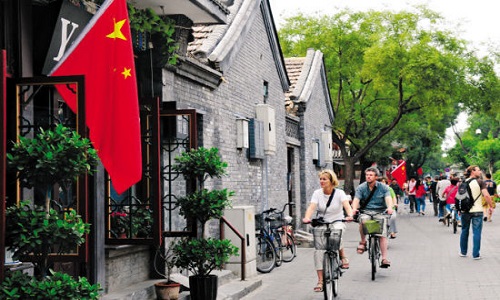
How to Get to the Confucius Temple in Beijing
1. By Subway – Quick and Convenient
The most efficient public transit option is the subway. Visitors can take Line 2 or Line 5 to Yonghegong Lama Temple Station. From the station, it’s only a five-minute walk to the temple entrance. This route is ideal for travelers who want a quick, budget-friendly option and prefer to avoid traffic. The walk from the station also allows a first glimpse of the surrounding streets and local atmosphere.
2. By Taxi or Ride-Hailing – Direct and Flexible
For those seeking convenience and flexibility, taxis or ride-hailing services such as DiDi provide direct access from anywhere in central Beijing. This option is especially useful for visitors carrying luggage, traveling with children, or arriving from nearby hotels. The ride usually takes around 15–25 minutes from central locations, depending on traffic, and drops you right at the temple’s main entrance.
3. Private Tour Option – In-Depth Cultural Insights
Another excellent way to visit is by booking a private tour with Your Way Holiday. A guided visit offers in-depth explanations of the temple’s history, architecture, and cultural significance. Guides can also help plan combined visits with nearby attractions such as Guozijian and the Lama Temple, ensuring a richer and more educational experience. This option is perfect for travelers looking for a personalized, immersive cultural journey.
Confucius Temple Beijing Opening Hours
1. April–October – Extended Visiting Hours
From April through October, the Confucius Temple is open daily from 8:30 AM to 6:00 PM. This period covers spring and summer, offering longer daylight for exploring the courtyards, halls, and steles. Visitors can take their time strolling through the spacious grounds, enjoy the seasonal blossoms, and capture photography in soft, natural light, making it an ideal season for leisurely visits.
2. November–March – Shorter Hours in Winter
During the colder months from November to March, the temple operates from 8:30 AM to 5:00 PM. Shorter daylight hours and winter weather make early arrival recommended to fully experience the temple before it closes. Despite the reduced hours, the winter season offers a calm and reflective atmosphere with fewer crowds, allowing visitors to enjoy the solemn beauty of the historical architecture and ancient cypress trees in a peaceful setting.
3. Closed on Major Holidays – Check Ahead
The Confucius Temple may close on certain major holidays or for maintenance, so it is always wise to check official announcements before your visit. Planning ahead helps avoid surprises and ensures your trip aligns with both temple access and nearby attractions. By staying informed, travelers can make the most of their time, perhaps combining the visit with Guozijian, the Lama Temple, or exploring nearby hutongs for a full-day cultural experience.
Travel Tips for Visiting the Confucius Temple in Beijing
1. Wear Comfortable Shoes – Easy Walking
The temple grounds are mostly stone-paved, and visitors often walk for extended periods while exploring courtyards, halls, and pathways. Wearing comfortable, supportive shoes is highly recommended to prevent fatigue or discomfort. Sturdy footwear allows you to move easily across uneven surfaces and enjoy the temple at a leisurely pace, making your visit more enjoyable and safe, especially if combining your trip with nearby attractions.
2. Bring Water and Light Snacks – Stay Refreshed
Although there are limited stalls inside the temple, bringing water and light snacks ensures you stay hydrated and energized while exploring. A small backpack with essentials allows you to enjoy the grounds without needing to leave for refreshments. This is particularly useful for families, older travelers, or anyone planning a full day of sightseeing, including nearby sites like the Guozijian or Nanluoguxiang Hutong.
3. Visit Early Morning or Late Afternoon – Avoid Crowds
For a more peaceful experience, plan your visit during early morning or late afternoon. These times generally see fewer visitors, giving you more space to admire the architecture, take photographs, and reflect on the temple’s history. Early visits also offer softer natural lighting, enhancing the beauty of courtyards and buildings, while late afternoons provide a calm, contemplative atmosphere as the sun casts long shadows across the historic grounds.
4. Photography Guidelines – Capture the Beauty
Photography is allowed throughout the temple courtyards, allowing visitors to capture the intricate architecture, stone steles, and serene landscapes. However, using flash inside the main halls, such as Dacheng Hall, is prohibited to protect the ancient statues and wooden carvings. Respecting these rules ensures the preservation of the temple while still allowing you to take memorable photos of your visit.
Night and Evening Experience at the Confucius Temple in Beijing
Visiting the Confucius Temple in the evening offers a completely different perspective compared to daytime tours, revealing a serene and almost mystical atmosphere. As dusk falls, the temple’s courtyards and pathways are softly illuminated by lanterns, casting warm, gentle light across the red walls, ceremonial gates, and ancient cypress trees. The quieter hours allow visitors to enjoy peaceful walks, contemplate the historical significance of the site, and fully appreciate the architectural details without the bustle of daytime crowds. Evening also provides excellent photo opportunities: the setting sun bathes the temple in golden tones, enhancing the contrast of the red-painted walls against the greenery of the cypresses, and creating dramatic shadows along the stone pathways. After exploring the temple grounds, travelers can continue their evening adventure by visiting nearby streets and night markets, sampling local snacks, or enjoying the lively yet intimate atmosphere of Beijing’s hutongs. A night visit to the Confucius Temple combines history, culture, and scenic beauty, offering a tranquil, reflective experience that perfectly complements daytime exploration and leaves a lasting impression of this iconic landmark.
.jpg)
.jpg)
Seasonal Festivals and Special Events at the Confucius Temple in Beijing
The Confucius Temple in Beijing hosts a variety of seasonal festivals and special events that celebrate Chinese culture and Confucian traditions. The most significant is Confucius’ birthday on September 28, marked by elaborate ceremonies featuring traditional music, ritual offerings, and formal bows to honor the “Great Sage and Teacher.” Visitors can witness the recreation of ancient rites, providing a vivid glimpse into historical practices. During national holidays, the temple occasionally hosts cultural events that highlight Confucian values such as respect, learning, and harmony. Additionally, seasonal exhibitions at the temple or the nearby Guozijian Academy showcase artifacts, calligraphy, and scholarly works, offering an engaging way to explore China’s rich intellectual history. These events create unique opportunities for visitors to experience the living cultural heritage of Confucianism and connect with centuries of scholarly and ceremonial tradition.
.jpg)
.jpg)
Interactive Workshops and Cultural Experiences at the Confucius Temple in Beijing
The Confucius Temple offers visitors more than just sightseeing—it provides hands-on cultural experiences that bring Chinese traditions to life. Calligraphy and seal carving workshops are popular activities, allowing guests to engage directly with artistic practices that have been central to Confucian education for centuries. Under the guidance of skilled instructors, visitors can learn the techniques of writing Chinese characters with brush and ink, or carve personal seals from stone, gaining a deeper appreciation for the skill, patience, and philosophy behind these traditional arts. These interactive workshops not only foster creativity but also connect participants with China’s scholarly heritage, making the temple experience immersive and memorable.
1. Calligraphy or Seal Carving Workshops
Visitors to the Confucius Temple can participate in specialized workshops designed to teach the fundamentals of Chinese calligraphy and seal carving. In these sessions, participants practice writing characters with traditional brushes and ink on rice paper, learning about stroke order, balance, and aesthetic harmony. Seal carving allows guests to design and engrave their own personalized stamps, echoing the practices of ancient scholars who used seals to authenticate their works. Both activities provide insight into Confucian values such as discipline, patience, and attention to detail, while also offering a tangible keepsake to remember the visit. These workshops are suitable for beginners and experienced participants alike, making them an engaging addition to any cultural itinerary.
.jpg)
.jpg)
2. Educational Activities for Students and Families
The temple also hosts educational programs tailored for students and families, providing an interactive way to learn about Confucian philosophy, Chinese history, and traditional rituals. Activities may include guided tours with interactive storytelling, hands-on demonstrations of ceremonial practices, and quizzes or games that reinforce learning about the temple’s historical and cultural significance. These programs are designed to make history and philosophy accessible and engaging for younger audiences, fostering curiosity and understanding of China’s intellectual traditions. By participating in these activities, families and students gain a more meaningful and memorable experience, connecting with the temple not only as a historical site but as a living center of cultural education.
.jpg)
.jpg)
Cultural Reflection and Visitor Experience at the Confucius Temple in Beijing
Visiting the Confucius Temple offers a profound opportunity to reflect on the enduring wisdom of Confucius in a tranquil and contemplative setting. Walking through the temple’s courtyards, beneath ancient cypress trees and along symmetrical stone pathways, visitors can sense the harmony that Confucian philosophy emphasizes—between nature, architecture, and human conduct. The temple provides a unique lens through which to understand how Confucian values have shaped Chinese society, influencing education, governance, and family life for centuries. Each hall, stele, and ceremonial space reflects principles of respect, benevolence, and moral cultivation, inviting visitors to appreciate not only the historical significance of the site but also the intellectual and spiritual legacy it preserves. By immersing themselves in this serene environment, guests experience a living connection to traditional Beijing, where culture, philosophy, and aesthetics converge to create a deeply meaningful and reflective visit.
Top Experiences at the Confucius Temple in Beijing Recommended by Your Way Holiday
We design private and Tailor-made Beijing Tours customized to your style of travel at affordable local prices. We will provide a private & spacious car and a local professional tour guide with over 5 years guiding experience only work for you or your group. Transport, ticket, and dining (We find the most authentic dishes popular with locals) all we will arrange for you according your requirements. Please check our most popular tours below:
Are the above sample tour programs not suitable for you? Dont worry, our Beijing tours can be tailor-made based on your requirements and budget to create unique Beijing experiences that allow you to interact with the local people and culture. We are Beijing travel experts who know what your guidebook and foreign agencies don't. Our enthusiastic tour expert will promptly reply you in details within 24 hours.
Prev: 798 Art Zone
Duration:7-8 Hours
Attractions(Cities):Tiananmen Square, Forbidden City, Temple of Heaven, Summer Palace
Tour Style:Experience the heart of Beijing on this one-day tour, designed to immerse you in the city’s rich history, culture, and beauty. Visit iconic landmarks such as Tiananmen Square, the Forbidden City, the Temple of Heaven, and the Summer Palace. Each site offers a unique glimpse into China’s imperial past, with expert guides sharing captivating stories and insights that bring history to life. As you explore, you’ll gain a deeper understanding of Beijing’s cultural heritage, from its grand palaces to its tranquil gardens. This Beijing tour offers personalized service, ensuring a comfortable and seamless experience. Whether you're a first-time visitor or returning to explore more, this tour is the perfect way to discover Beijing’s timeless treasures in a single, unforgettable day.
Duration:2 Days, 1 Night
Attractions(Cities):Temple of Heaven, Tiananmen Square, Forbidden City, Nanluoguxiang, Mutianyu Great Wall, Summer Palace
Tour Style:Embark on a fascinating 2-day adventure in Beijing, where history and modernity blend seamlessly. Begin with the majestic Temple of Heaven and the iconic Tiananmen Square, before discovering the grandeur of the Forbidden City, an imperial treasure trove. Explore the lively Nanluoguxiang, where traditional architecture meets vibrant city life. On day two, enjoy breathtaking views from the Mutianyu Great Wall, a marvel of ancient engineering, and immerse yourself in the serene beauty of the Summer Palace, with its lush gardens and elegant pavilions. This thoughtfully crafted tour offers the perfect mix of historical insights and cultural experiences, designed to captivate your senses and spark your curiosity, leaving you with lasting memories of Beijing.
Duration:3 Days, 2 Nights
Attractions(Cities):Tiananmen Square, Forbidden City, Temple of Heaven, Jingshan Park, Summer Palace, Kunming Lake Boat Riding, Nanluoguxiang, Panjiayuan Antique Market, Mutianyu Great Wall, Bird's Nest, Water Cube
Tour Style:Immerse yourself in Beijing’s rich history and vibrant culture with our exclusive 3-day private tour. Start by exploring Tiananmen Square and the majestic Forbidden City, then visit the serene Temple of Heaven. Enjoy sunset views from Jingshan Park and a scenic boat ride on Kunming Lake at the Summer Palace. Wander through the lively Nanluoguxiang Hutong, hike the breathtaking Mutianyu Great Wall, and marvel at the modern Bird’s Nest and Water Cube. This personalized tour seamlessly blends historical landmarks, cultural experiences, and stunning architecture, ensuring an unforgettable journey. Every moment is designed to captivate, inspire, and leave you with lasting memories of Beijing’s unique charm and diverse beauty.
Duration:5 Days, 4 Nights
Attractions(Cities):Mutianyu Great Wall, Bird's Nest, Water Cube, Qianmen Street, Morning Market, Forbidden City, Tiananmen Square, Jingshan Park, Temple of Heaven, Nanluoguxiang, Facial Makeup Painting, 798 Art Zone
Tour Style:Immerse yourself in Beijing’s rich culture and history with our comprehensive Beijing tour package. This thoughtfully crafted itinerary takes you to iconic landmarks such as the Mutianyu Great Wall, Forbidden City, and Tiananmen Square, alongside modern architectural wonders like the Bird’s Nest and Water Cube. Experience local life at Qianmen Street and the Morning Market, and discover the city’s vibrant art scene at the 798 Art Zone. Engage in hands-on activities, including traditional facial makeup painting. With expert guidance from a seasoned Beijing travel expert, this tour seamlessly combines historical exploration with cultural immersion, offering an unforgettable Beijing experience. Each moment is designed to leave you with lasting memories of this dynamic city.
Duration:10+ Hours
Attractions(Cities):Terracotta Warriors and Horses Museum
Tour Style:Embark on a captivating day trip from Beijing to Xi'an to explore the iconic Terracotta Warriors. This Beijing-Xi'an tour offers a fascinating journey through ancient Chinese history, highlighting the world-renowned Terracotta Army. Visit this monumental archaeological site, home to thousands of life-sized soldiers, horses, and chariots, each crafted with intricate details. With the guidance of an expert, learn about the historical significance of these remarkable figures and their role in China’s ancient imperial past. Enjoy seamless travel and smooth logistics, ensuring a stress-free experience as you delve into the history and culture of this extraordinary site. This day trip promises an enriching and memorable exploration of one of China’s most treasured landmarks.
Wechat: Chinaprivatetour
24 Hours Hotline:
+86 137-3541-1378
(Your Privacy is Protected)
1 to 1 tailor-made service from our professional travel advisors for the most sophisticated
Constantly excellent reviews for attraction, hotel and service Competitive price
Local experts provide quality tours Best selected knowledgeable local guides Authentic local restaurants
7*24 hours available to create you a worry-free tour. No Hidden Fees and absolutely no pressure to buy. Secured









Copyright © 2017 Chinabeijingprivatetour.com All rights reserved. 浙ICP备18056007号-2